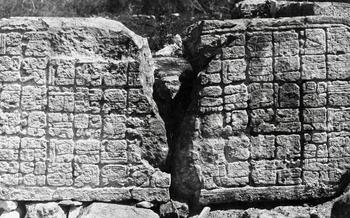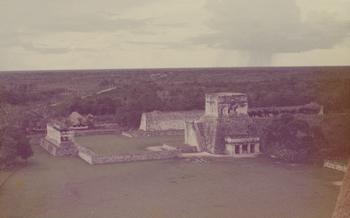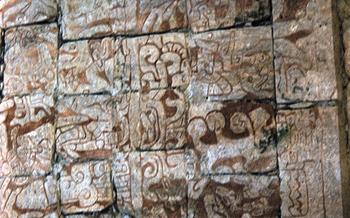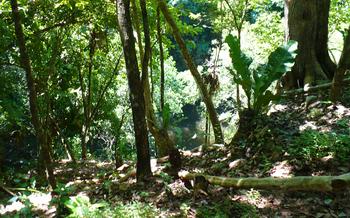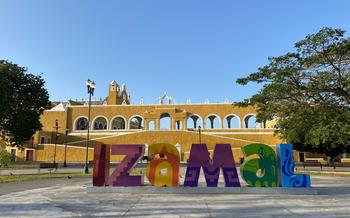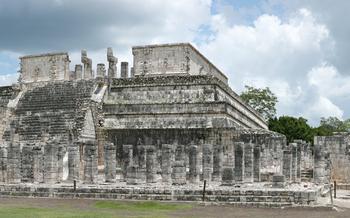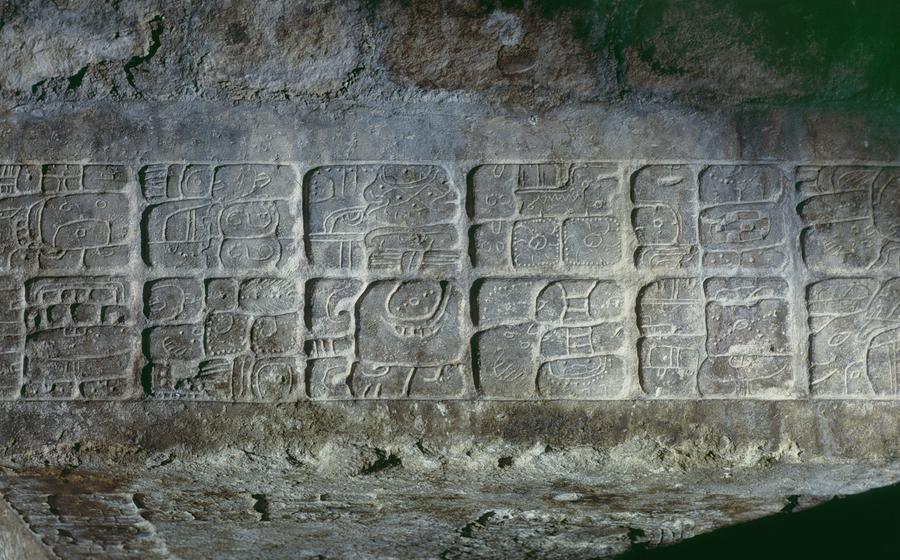
Akab Dzib
- Exploring the Grounds
- History and Culture
- Architectural wonders
- The Pyramid of the Magician
- The Temple of the Warriors: A Symbol of Mayan Prowess
- The Temple of the Nuns
- The Market
- The Museum
- The Cenote
- Photography
- Cultural Performances: A Journey into Mayan Traditions
- Local Cuisine:
- Dress Code and Etiquette
- Insider Tip:
Exploring the Grounds
The Akab Dzib grounds are an archaeological wonderland, beckoning visitors to journey through time and uncover the secrets of the ancient Mayans. As you wander along the main plaza, marvel at the Templo de los Mascarones, its intricate carvings and stucco decorations narrating tales of gods, warriors, and mythical creatures. The Hall of Columns, with its rows of towering pillars and vaulted ceiling, transports you to a time when priests and rulers gathered for sacred ceremonies. Descend into the depths of the cenote, a natural sinkhole filled with crystal-clear water, and feel the mystical energy that emanates from this sacred well.
History and Culture
The Akab Dzib, a testament to the grandeur of the Mayan civilization, was constructed around 500 AD. Its significance lies in its role as a religious and ceremonial center. The Mayans held sacred rituals and ceremonies within its sacred grounds, invoking their deities and seeking guidance and protection. The architecture and iconography of the site reflect the deeply spiritual nature of the Mayan people. Symbols of Mayan gods, such as Chaac, the god of rain, and Itzamna, the creator god, are depicted in the carvings and sculptures, providing a glimpse into their rich mythology and religious beliefs. The Akab Dzib stands as a testament to the spiritual and cultural heritage of the Mayans, offering visitors a chance to connect with the ancient civilization's profound beliefs and practices.
Architectural wonders
The Akab Dzib showcases a distinctive architectural style that sets it apart from other Mayan sites. Constructed using locally sourced materials like limestone and stucco, the buildings at Akab Dzib demonstrate the remarkable ingenuity of the Mayan builders. The use of intricate carving techniques, corbelled arches, and elaborate facades creates a visually stunning and awe-inspiring environment.
Preservation efforts and ongoing restoration work are crucial in safeguarding the architectural integrity of Akab Dzib. Archaeologists and conservators work diligently to protect and restore the site, ensuring that future generations can continue to appreciate its historical and cultural significance.
Akab Dzib's contribution to Mayan architectural heritage is immeasurable. Its unique style and construction techniques have influenced and inspired generations of architects and builders, cementing its place as a cornerstone of Mayan cultural heritage.
The Pyramid of the Magician
At the heart of the Akab Dzib stands the Pyramid of the Magician, an awe-inspiring structure that dominates the site's skyline. Its unique design, known as "step-pyramid," features nine ascending levels, creating a majestic silhouette against the sky. The pyramid derives its name from a legend that attributes its construction to a powerful magician who possessed supernatural abilities. According to the tale, the magician conjured the pyramid in a single night, using only his magical powers.
Ascending the pyramid's steep steps is a challenging yet rewarding experience. The climb offers breathtaking views of the surrounding landscape, with the lush vegetation of the Yucatan peninsula stretching out in all directions. The summit of the pyramid provides an unparalleled panorama, allowing visitors to fully appreciate the grandeur of the Akab Dzib and the surrounding Mayan ruins.
The Temple of the Warriors: A Symbol of Mayan Prowess
Among the many awe-inspiring structures at Akab Dzib, the Temple of the Warriors stands out as a testament to Mayan military prowess. This imposing edifice, adorned with intricate carvings depicting fierce warriors engaged in battle, showcases the Mayans' exceptional craftsmanship and their reverence for warfare.
The temple's facade is a masterpiece of Mayan artistry, featuring elaborate sculptures of warriors adorned with intricate headdresses and ceremonial attire. These carvings provide a glimpse into the lives and customs of the ancient Mayan warriors, who played a crucial role in defending their civilization and expanding its territories.
Venturing into the temple's interior reveals a series of chambers and passageways, each adorned with unique carvings and murals that narrate the stories of legendary battles and heroic feats. Visitors can explore these chambers and discover the secrets they hold, gaining a deeper understanding of the significance of warfare in Mayan culture.
The Temple of the Warriors serves as a powerful reminder of the strength, courage, and resilience of the ancient Mayans. Its imposing presence and intricate carvings transport visitors back in time, allowing them to witness the grandeur and might of one of the world's most remarkable civilizations.
The Temple of the Nuns
The Temple of the Nuns, located within the Akab Dzib archaeological site, holds a unique significance as a religious center dedicated to female deities in Mayan culture. This sacred space showcases intricate carvings and stucco decorations, paying homage to the goddesses and their roles in Mayan society. The temple's design and symbolism shed light on the importance of women in Mayan culture, often overlooked in traditional narratives. Visitors can explore the temple's interior, marveling at the exquisite artistry and learning about the mysterious legends associated with this sacred site. The Temple of the Nuns offers a glimpse into the complex and multifaceted nature of Mayan beliefs and practices, providing a deeper understanding of this ancient civilization's rich cultural heritage.
The Market
In the heart of the Akab Dzib, a vibrant marketplace bursts with colors, sounds, and aromas. This lively bazaar offers an authentic glimpse into Mayan culture and provides a unique opportunity to support local artisans. From intricately woven textiles to colorful pottery and hand-carved wooden sculptures, the market is a treasure trove of handcrafted goods.
Bargaining is an integral part of the market experience, and visitors are encouraged to engage with vendors in friendly negotiations. With a smile and a few kind words, you can often secure a great deal on a one-of-a-kind souvenir. Every purchase you make directly supports the local economy and helps sustain the livelihoods of these talented craftspeople.
The Museum
In addition to exploring the ruins and immersing yourself in the ancient history of the Akab Dzib, you can also visit the onsite museum to delve deeper into the Mayan civilization and its rich cultural heritage. The museum houses a collection of artifacts and findings excavated from the archaeological site, providing valuable insights into the daily lives, religious beliefs, and artistic traditions of the Maya.
Informative exhibits showcase chronologically the Mayan history, from their early settlements to the rise and fall of their mighty civilization. You'll learn about their social structure, political systems, advancements in mathematics and astronomy, and the development of their complex system of writing.
Interactive displays and educational programs make learning about Mayan culture engaging and enjoyable. Touchscreens, videos, and hands-on exhibits bring the ancient world to life, allowing you to experience the ingenuity and creativity of the Maya firsthand.
The Akab Dzib museum is an invaluable resource for understanding the significance of this remarkable site and the broader context of Mayan civilization. It serves as a repository of knowledge, preserving and showcasing the legacy of this ancient society for generations to come.
The Cenote
The Akab Dzib is home to a remarkable natural wonder – a cenote. This sinkhole, with its crystal-clear water, holds immense religious and spiritual significance for the ancient Mayans. They believed cenotes were portals to the underworld, Xibalba, and were used for sacred ceremonies and rituals. The cenote at Akab Dzib was likely used for purification rituals, offerings to the gods, and communication with the spirit world. Today, visitors can swim, snorkel, or dive in the cenote, experiencing the beauty of this natural wonder while connecting with the ancient Mayan culture. The cenote's unique ecosystem, with its diverse aquatic life, offers a glimpse into the rich biodiversity of the Yucatán Peninsula.
Photography
Capturing the essence of the Akab Dzib through photography is an incredible way to document your visit and share the site's beauty with others. Here are some tips to help you take stunning photos:
-
Lighting: Aim to visit during the golden hours of dawn or dusk for the best lighting conditions. The warm, diffused light will enhance the colors and textures of the ruins, producing more vibrant images.
-
Composition: Experiment with different angles and perspectives to create dynamic compositions. Look for leading lines, such as the pathways or archways, to draw the viewer's eye into the image.
-
Respect: Remember that you are visiting a sacred and historical site. Be respectful of the ruins and the people around you. Avoid using flash photography, as it can be disruptive to others and damage the fragile structures.
-
Cultural Sensitivity: Ask permission before photographing local people, especially those engaged in religious ceremonies or activities. Showing respect for the local culture will ensure a positive experience for everyone involved.
Cultural Performances: A Journey into Mayan Traditions
Immerse yourself in the vibrant tapestry of Mayan culture through captivating performances that bring ancient traditions to life. Talented dancers adorned in intricate costumes showcase mesmerizing footwork and graceful movements, accompanied by the rhythmic beats of traditional Mayan music. Storytellers transport you back in time with captivating tales that narrate the rich history and mythology of the Maya. These performances offer a unique opportunity to witness the enduring spirit of Mayan culture, showcasing its diversity and resilience. Embrace the magic of these live shows, where the past and present intertwine, leaving you with a profound appreciation for the cultural heritage of the Maya.
Local Cuisine:
Indulge in the culinary delights of the Yucatan Peninsula by sampling authentic Mayan dishes and regional delicacies. Tantalize your taste buds with cochinita pibil, a traditional slow-roasted pork dish infused with achiote paste and wrapped in banana leaves. Savor the flavors of panuchos, a fried tortilla topped with refried black beans, shredded turkey, and pickled red onions. Experience the unique blend of Mayan and Spanish influences in local cuisine. Discover the secrets behind the vibrant colors and rich flavors that characterize Yucatecan gastronomy. Support local restaurants and the culinary scene by savoring the diverse offerings of the region. Embark on a culinary journey that will leave your taste buds dancing and your soul satisfied.
Dress Code and Etiquette
When visiting a place as sacred and historically significant as the Akab Dzib, it's important to be mindful of proper attire and etiquette. Dress respectfully to show reverence for the site's cultural and religious importance. Avoid wearing skimpy or revealing clothing, and opt for comfortable, modest outfits that cover your shoulders and knees.
Be mindful of your behavior and actions. Refrain from engaging in disruptive activities or making loud noises that may disturb the tranquility of the site. Respect the privacy of local people by asking permission before taking their photos. Observe local customs and traditions, and avoid any actions that may be considered disrespectful. By showing respect and understanding, you can contribute to preserving the cultural heritage of the Akab Dzib and ensure a positive experience for all visitors.
Insider Tip:
To fully appreciate the grandeur of the Akab Dzib without the throngs of tourists, arrive as early as possible. The site opens at 8 am, and the first few hours are generally the quietest. Not only will you avoid the heat and crowds, but you'll also have the chance to soak in the tranquility of the surroundings and capture some stunning photos without people in the background. It's an experience that will make your visit even more memorable.
Remember to wear comfortable shoes suitable for walking on uneven terrain, as the paths can be rocky and slippery. Stay hydrated by bringing plenty of water, especially during the hot and humid summer months. Apply sunscreen regularly to protect your skin from the intense sun. And don't forget insect repellent, as mosquitoes can be a nuisance, particularly during the rainy season. With these tips in mind, you're all set to embark on an unforgettable journey through the ancient Mayan world at the Akab Dzib.
